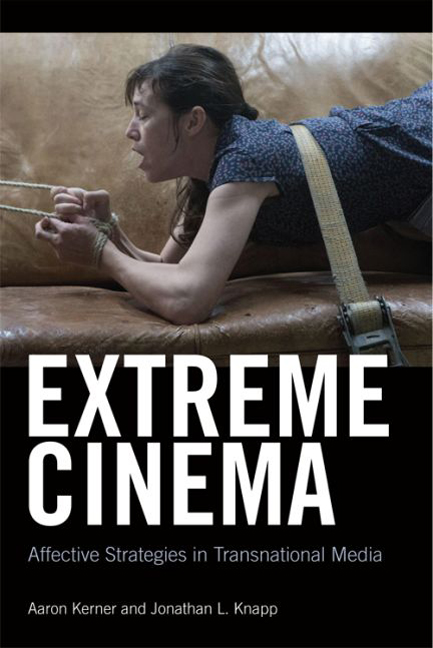Book contents
- Frontmatter
- Contents
- List of Figures
- Acknowledgments
- 1 Extreme Cinema: Revisiting Body Genres
- 2 Hearing: With a Touch of Sound—The Affective Charge of Audio Design
- 3 Pain: Exploring Bodies, Technology, and Endurance
- 4 Laughter: Belly-aching Laughter
- 5 Arousal: Graphic Encounters
- 6 Crying: Dreadful Melodramas—Family Dramas and Home Invasions
- 7 The End of Extreme Cinema?
- Bibliography
- Filmography
- Index
2 - Hearing: With a Touch of Sound—The Affective Charge of Audio Design
- Frontmatter
- Contents
- List of Figures
- Acknowledgments
- 1 Extreme Cinema: Revisiting Body Genres
- 2 Hearing: With a Touch of Sound—The Affective Charge of Audio Design
- 3 Pain: Exploring Bodies, Technology, and Endurance
- 4 Laughter: Belly-aching Laughter
- 5 Arousal: Graphic Encounters
- 6 Crying: Dreadful Melodramas—Family Dramas and Home Invasions
- 7 The End of Extreme Cinema?
- Bibliography
- Filmography
- Index
Summary
INTRODUCTION: FROM A GRIND TO A SCREAM
It has been, as the film's title reminds us, nearly 127 hours. Aron, a thrillseeking climber, is deep in the backcountry of Canyonlands National Park, in southeastern Utah, trapped at the bottom of a slot canyon, his right arm stuck between a boulder and the canyon wall. Various attempts to dislodge the boulder have failed, and an earlier effort to slice through his arm with a cheap pocketknife ended when the dull blade came up against a material it could not cut: bone. Aron's last hope for survival is to break these bones, so he thrusts his body up and away from the wall, a forceful movement that the camera mirrors by quickly jolting from the boulder to the empty corridor behind him. A sharp snap penetrates the space. The image cuts back to a close-up of Aron's face as he gasps in pain. To fully get the bone out of the way requires more precise work: he digs into his ripped flesh, wraps his left hand around the broken bones, and physically pulls the dense tissue away from his forearm, which marks the boundary between his living flesh and what he will soon leave for dead. The camera focuses in close-up on Aron's face as he does this, clenching his teeth, grunting and grimacing with pain. A loud pop bursts forth as Aron jerks his head back, allowing sunlight reflecting off the canyon wall to completely envelop the image. Aron's gasps of pain quickly turn into howls of laughter: he has successfully cleared the bone.
After removing tears from the corners of his eyes, Aron prepares the blade. The camera cuts constantly between different angles of the scene, as he slices open his flesh, digging his fingers into the gash to remove gobs of bloody skin, muscle, tendon, and vein. The procedure moves along slowly, but steadily, until the knife meets a thin, stringy, white fiber: a nerve. From a high angle, the camera peers over Aron's shoulder, down at the arm, flayed open, nerve exposed. As the blade touches the nerve, an electronic grinding noise overtakes all other sound. The camera swerves upward to Aron's shocked face, as if in response to this sudden eruption of noise.
- Type
- Chapter
- Information
- Extreme CinemaAffective Strategies in Transnational Media, pp. 21 - 44Publisher: Edinburgh University PressPrint publication year: 2016



